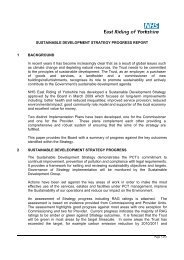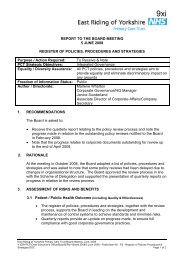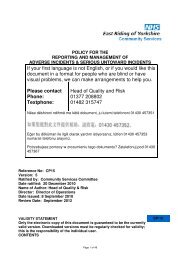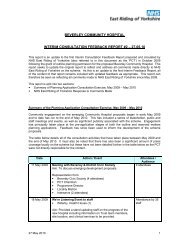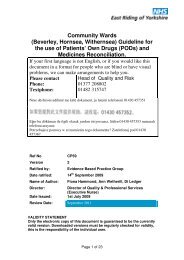Guidelines for the Management of Haematological Malignancies
Guidelines for the Management of Haematological Malignancies
Guidelines for the Management of Haematological Malignancies
You also want an ePaper? Increase the reach of your titles
YUMPU automatically turns print PDFs into web optimized ePapers that Google loves.
explains <strong>the</strong> resistance to conventional chemo<strong>the</strong>rapeutic agents. The only licensed <strong>the</strong>rapy <strong>for</strong><br />
fludarabine-refractory CLL is alemtuzumab. The response rates to alemtuzumab are most influenced<br />
by <strong>the</strong> size <strong>of</strong> lymphadenopathy. The duration <strong>of</strong> remission and survival following alemtuzumab are<br />
related to <strong>the</strong> depth <strong>of</strong> remission including whe<strong>the</strong>r minimal residual disease is eradicated. It is<br />
recommended that <strong>the</strong>se patients are referred <strong>for</strong> consideration by <strong>the</strong> specialist CLL MDT. The<br />
following approaches are indicated <strong>for</strong> patients with refractory CLL who are considered suitable <strong>for</strong><br />
intensive treatment:<br />
CLL206(CamPred) trial: Phase II trial <strong>for</strong> Fludarabine refractory patients with p53 deletion analysing<br />
<strong>the</strong> efficacy <strong>of</strong> high dose steroids and alemtuzumab. (Level 1 or 2)<br />
Patients with predominantly blood and marrow disease with relatively small lymph nodes should be<br />
treated with alemtuzumab. (Moreton, Kennedy et al. 2005)The aim <strong>of</strong> <strong>the</strong>rapy should be to eradicate<br />
detectable minimal residual disease from <strong>the</strong> marrow.<br />
Patients with bulky lymphadenopathy should receive initial <strong>the</strong>rapy to reduce <strong>the</strong> bulk <strong>of</strong> lymph nodes<br />
prior to treatment with alemtuzumab in order to eradicate detectable minimal residual disease. Highdose<br />
methyl prednisolone (1g/m 2 /day <strong>for</strong> 5 days every 4 weeks) is effective in patients <strong>for</strong> whom high<br />
dose steroids are not contra-indicated. (Level 1)<br />
Allogeneic stem cell transplantation<br />
CLL is an incurable disease by conventional treatment approaches. The transplant related morbidity<br />
and mortality <strong>for</strong> allogeneic stem cell transplantation is very high. However <strong>the</strong>re is a significant graftversus-CLL<br />
effect and long-term disease free survival is achievable following allogeneic stem cell<br />
transplantation. Patients who are possible candidates <strong>for</strong> allogeneic stem cell transplantation should<br />
be considered by <strong>the</strong> MDT in Leeds on a case-by-case basis. Patients are generally only considered<br />
<strong>for</strong> allogeneic transplantation if <strong>the</strong>y have poor-risk disease ei<strong>the</strong>r according to biological<br />
characteristics <strong>of</strong> <strong>the</strong>ir CLL or because <strong>the</strong>y have fludarabine-refractory disease. (Level 4)<br />
<strong>Guidelines</strong> <strong>for</strong> <strong>the</strong> <strong>Management</strong> <strong>of</strong> <strong>Haematological</strong> <strong>Malignancies</strong><br />
8. CHRONIC LYMPHOCYTIC LEUKAEMIA<br />
20





